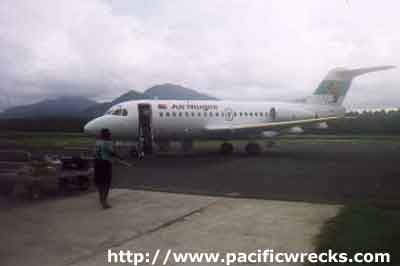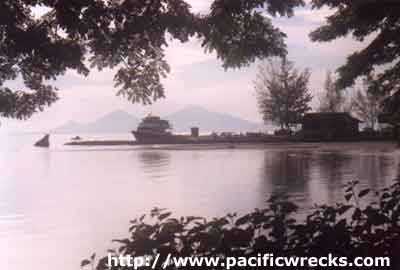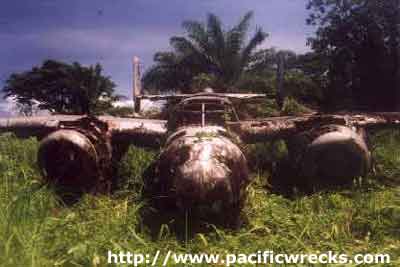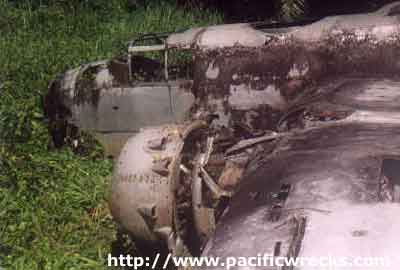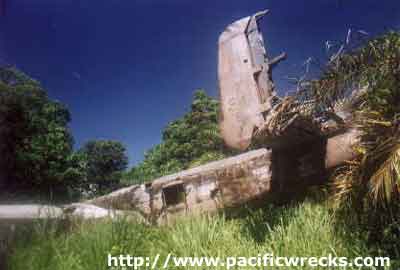Operation Lik Lik Walkabout 2001
|
by Phil Bradley Walkabout
2001 Cecilie Benjamin from Walindi Resort had kindly made available a room at the resort for the night and the driver picked me up from the airport. A cool drink was appreciated but I initially mistook the cool rolled up blue towel for some sort of exotic food before gratefully mopping the sweaty brow. Hoskins had been a major Japanese airbase during the war and aerial shots showed an extensive dispersal area amongst the coconut palms to the south of the strip. Worth some investigation at some time. Cecilie later showed me a great photo taken by an Australian Beaufighter pilot as he buzzed the control tower. Ki-46
Dinah Wreckage The wreck, a Ki-46 Dinah is a sorry sight compared to what it was. A photo taken in 1988 showed considerable remains, but in the last few years some irresponsible types have got at it. This comparison taken from the same angle clearly shows the deterioration caused by vandals.) Still readily identifiable though. It had crash landed on what was formerly clear coastal land only 100 metres or so from the water's edge. Now the wreck lies amidst the oil palm trees so prevalent in this region. When the arguments are made about the value of plane wrecks left in sit or in museums, this type of situation certainly supports the relocation and thus preservation of the aeroplane. The Ki-46 Dinah was one of the most capable aircraft to come out of Japan during the war. |
|
|||||||
|
Walindi
Resort The guesthouses are set out along the coast, open to the breeze coming off the bay, and a large "Haus Win" has been set up for eating, drinking or just chilling out looking over the calm waters of the bay or the adjacent swimming pool. Diving facilities are top class with all equipment available as well as fully equipped dive boats and a top class dive master. Add to that a fully equipped photo and video editing lab and you have the makings of a great underwater experience. Vist walindi.com for more information. |
|
|||||||
| A6M2
Zero B-25H
Mitchell B-25H 43-4513 was from the 100th Bomb Squadron from the 42nd Bomb Group based in the Solomons and its final take off was from Coronus airstrip on the Stirling Islands on September 3rd 1944. Part of a flight of three Mitchells piloted by Captain Wolfendale, the mission was to patrol the New Britain coast for enemy transports. The weather was very poor as the planes approached New Britain but as they followed the coast down past Cape Orford an enemy tug with supply barges in tow was spotted heading to Palmalmal with supplies from Rabaul. Out in the open water with only LMG defence, the Japanese were an easy target and Wofendale's Mitchell blew the tug out of the water with the fearsome T9E1 75mm chin gun. But soon thereafter trouble struck as one of the Wright R-2600 radial engines failed and the other started to run rough. Knowing he had to get down in a hurry, Wolfendale headed for the emergency strip at Talasea where he blew the nose tyre and collapsed the front landing gear, but got the plane down OK. The plane was towed to the end of the strip and left where it sits today. RNZAF
Ventura NZ4522 He was piloting one of three Venturas that early morning as he battled heavy rain on the way to the target. On his first bomb run only 4 of the 6 bombs dropped away, so after a strafing run he went around and dropped the remainder. Then on a second strafing run he lost his starboard engine at 1100 feet. He tried to restart but with no luck, so he feathered the airscrew and sent out an emergency radio call. But the turret gunner had shot away the aerial so as Thomas turned south for the Williamez Peninsula he knew his crew were on their own. (Photos: Ventura1x, Ventura2x) With only the one engine, Thomas was steadily losing height and at 500 feet the crew prepared for ditching as they jettisoned guns, door and other odds and ends. Now at 100 feet, Thomas angled his plane under a cloud in the hope of gaining some lift, glider fashion. After he had passed the cloud, the plane had risen to 900 feet, allowing further progress. Soon down again to 200 feet, another cloud allowed Thomas to claw his way back to 800 feet. This was enough altitude to get him to Talasea and he made a left hand turn and lined up on the emergency strip at 300 feet. It was 0915, two hours since leaving Kerevat as Thomas put the Ventura down at 80 knots with 85 degrees of flap. The soft ground helped the plane to pull up and on alighting. Thomas found a 20mm shell had severed the starboard engine fuel line. Thomas and his crew were soon picked up and taken to Erimau, though not without further incident. Sitting alongside the pilot, Thomas saw him about to enter a cloud bank at 1000 feet and warned him there were 1500 feet mountains amongst the islands therein. They diverted but an accompanying B-25 did not and was lost. Fred Thomas was awarded the Distinguished Flying Cross for his extraordinary flight in the Ventura.
|
|
|||||||
|
RAAF
Mk Vc Spitfire The pilot, Flight Lieutenant Llew Wettenhall's name is commemorated on the new St Remo memorial on the shore in nearby Kimbe. There is a photo in the Australian War Memorial (P02875.165) of Wettenhall's plane taken at Kiriwina in September 1943 and another of Llew Wettenhall himself taken in November 1943 (P02874.117)
|
|
|||||||
|
St.
Remo Memorial The St Remo memorial is dedicated to all those RAAF men lost during the fighting over New Britain. (G.Gill should in fact represent Captain Tom Gill, an Australian army air liaison officer who was in a B25 shot down following a raid on Rabaul on 10th September 1943. The crew got out and a rescue Catalina from Kiriwina was called for them by Vic Tatelman's accompanying B-25. But tragically when Taltelman landed at Kiriwina, the Catalina had not yet left. The Japanese got to them first and the downed crew were executed. ) Also at the St Remo club was displayed the Bristol Hercules engine and propeller from Beaufighter A-19-133, also lost near Kimbe. Upcoming
Updates Phil Bradley Main Page
|
|
